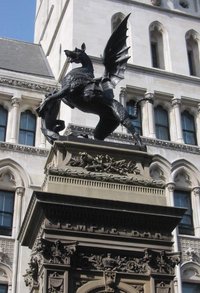Temple Bar, London
|
|
Temple Bar is the barrier (real or imaginary) marking the westernmost extent of the City of London on the road to Westminster, where Fleet Street (extending westwards) becomes the Strand. Until 1878 this boundary was demarcated by a stone gateway.
In the Middle Ages, the authority of the Corporation of London reached beyond the city's ancient walls in several places (the liberties of London); to regulate trade into the city, barriers were erected on the major roads wherever the true boundary was a substantial distance from the old gatehouse. Temple Bar was the most famous of these, since traffic between London (England's prime commercial center) and Westminster (the political center) passed through it. Its name comes from the Temple Church (an old complex once owned by the Knights Templar but now home to two of the legal profession's Inns of Court), which is located nearby.
It has long been the custom that a king or queen stop at Temple Bar before entering the City of London, so that the Lord Mayor may offer him or her the City's pearl-encrusted Sword of State as a token of loyalty. This picturesque ceremony has often featured in art and literature. However, the popular view that the monarch requires the Lord Mayor's permission to enter the City is incorrect.
Today Temple Bar (like other major entrances to the City of London) is marked by a stone monument in the middle of the roadway, topped by a statue of a griffin (two of which feature in the City's arms as supporters).
The bar itself
The earliest Temple Bar may have been no more than a turnpike; there was a gate of some kind from 1293. One was badly damaged during the Peasants' Revolt in 1381.
By the late Middle Ages a wooden archway (with a prison above) stood on the spot. Badly damaged in 1666 by the Great Fire of London, it became necessary to rebuild the structure. Commissioned by King Charles II, and designed by Sir Christopher Wren, the fine arch of Portland Stone was constructed between 1669 and 1672. During the 18th century, the heads of traitors were mounted on pikes and exhibited on the roof.
Temple_Bar_in_the_1870s._Photographer_York_&_Son.jpg
The other seven principal gateways to London (Aldgate, Aldersgate, Bishopsgate, Cripplegate, Ludgate, Moorgate and Newgate) had all been demolished by 1800, but Temple Bar remained as an impediment to the ever-growing traffic. In 1878 the Corporation of London, eager to widen the road but unwilling to destroy so historic a monument, dismantled it piece-by-piece in an 11-day period and stored its 2,700 stones carefully.
In 1880, the brewer Sir Henry Meux bought the stones (at the instigation of his wife, a barmaid he married amid much scandal) and re-erected the arch as a gateway at his house, Theobalds Park, between Enfield, and Cheshunt in Hertfordshire.
It remained there, incongruously sitting in a clearing in a wood, until 2003. By then it had been purchased by the Temple Bar Trust from the Meux Trust for £1 in 1984. It was carefully dismantled and returned on 500 pallets to the City of London where it was being painstakingly re-erected as an entrance to the Paternoster Square redevelopment just north of St Paul's Cathedral. It opened to the public in late 2004.
See also
- Temple Bar, Dublin — district of the same name in Dublin, Ireland
External Links
- http://www.thetemplebar.info — website about the restoration of the gatewayhe:טמפל בר

